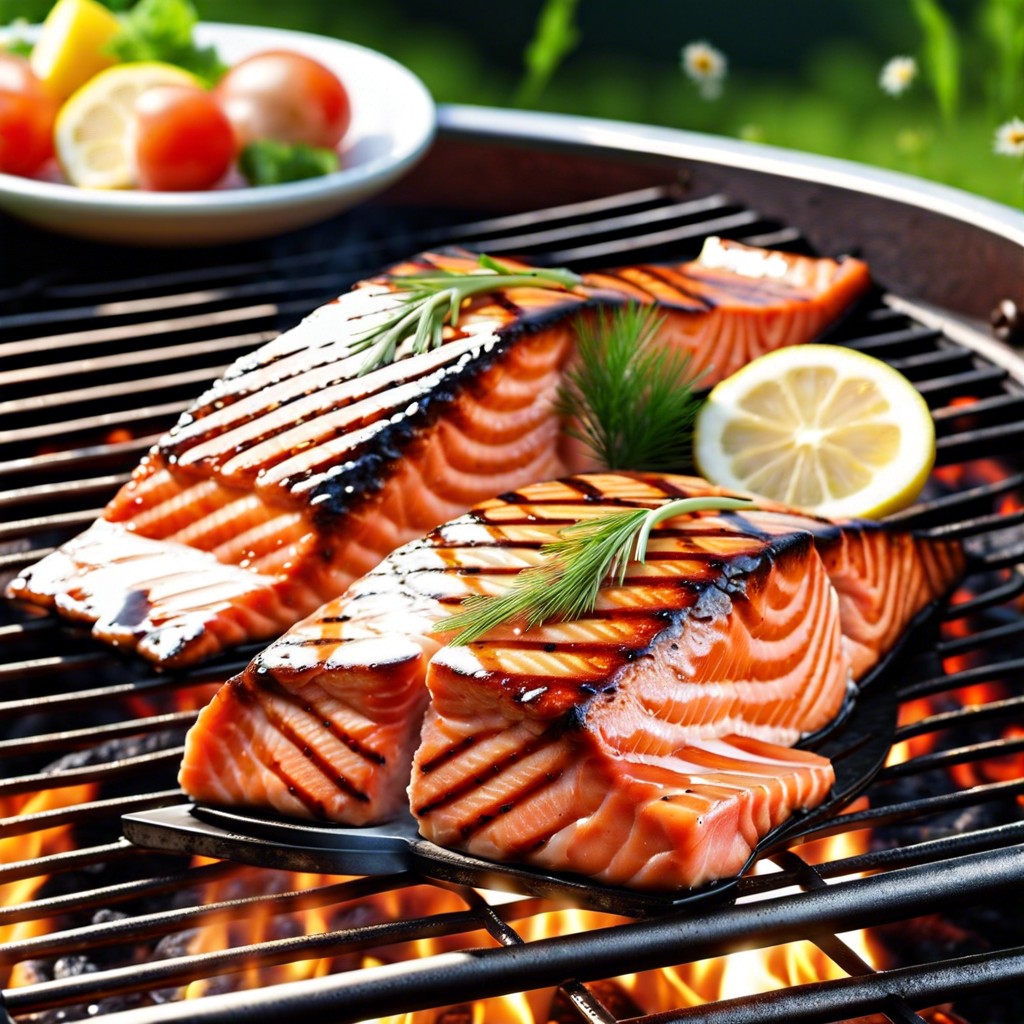Grilled salmon achieves optimal flavor and texture by mastering the right heat level, timing, and seasoning; this article provides practical steps to perfect this classic dish on your grill.
Key takeaways:
- Opt for fresh, high-quality salmon for optimal flavor and texture.
- Leave the skin on to prevent sticking and preserve moisture.
- Use a combination of olive oil, lemon zest, garlic, and fresh dill for simple yet effective flavoring.
- Grill the salmon skin-side down, flipping only once to minimize breaking.
- Serve with sauces like dill and lemon butter or whiskey glaze, and pair with sides like roasted vegetables or garlic-infused mashed potatoes.
The Best Salmon for Grilling

Opting for fresh, high-quality salmon significantly impacts the flavor and texture after grilling. Wild-caught varieties like King, Sockeye, or Coho are renowned for their rich taste and firm texture, making them ideal candidates. However, farmed Atlantic salmon offers a high fat content which can contribute to a moist, tender result and is more widely available.
When selecting salmon, aim for consistency in thickness to ensure even cooking. Skin-on fillets can provide a protective layer against the heat of the grill and help to retain the fish’s natural moisture. Look for vibrant color, a fresh sea smell, and flesh that springs back when pressed – all indications of salmon’s freshness.
For those seeking environmental sustainability, prioritize salmon certified by the Marine Stewardship Council or rated as Best Choices or Good Alternatives by the Monterey Bay Aquarium’s Seafood Watch program.
Ingredients for This Grilled Salmon
To ensure your grilled salmon is a standout dish, start with a quality cut. Opt for fresh, wild-caught salmon when available, as it offers superior texture and flavor compared to farm-raised options. Coho, King, and Sockeye are excellent choices.
Now focus on the skin – it’s your ally for preventing sticking and preserving moisture, so leave it on. Before marinating or seasoning, pat the fish dry to help the skin crisp up beautifully on the grill.
For simple yet effective flavoring, consider a combination of olive oil, lemon zest, garlic, and fresh dill. These ingredients enhance the natural taste of the salmon without overpowering it. Kosher salt and black pepper are musts for a well-seasoned fish.
Keep your seasoning balanced; a heavy hand can easily mask the delicate flavors of the salmon. Fresh, high-quality ingredients will make a distinct difference in the end result, turning a regular grilled salmon into an extraordinary meal.
How to Grill Salmon
Choose salmon with the skin on to prevent the fish from falling apart during grilling and to achieve a crispy texture. Preheat the grill to a medium-high heat of approximately 375-450°F, and oil the grates to prevent sticking.
Before placing the salmon on the grill, pat it dry with paper towels and apply a thin layer of oil to both sides. Season with salt, pepper, and any additional spices or herbs you prefer.
Place the salmon skin-side down directly on the grill. Do not move the fish immediately; this gives the skin time to crisp.
Cook for about 6-8 minutes until the skin is crisp and the fish releases easily from the grates. Use a spatula to carefully flip, only once, to minimize the risk of the salmon breaking.
Grill for an additional 3-6 minutes on the other side. Cooking time varies depending on thickness, but aim for an internal temperature of 145°F for a well-done fillet. For medium-rare, look for a temperature of about 125°F. Remember that the fish will continue to cook from residual heat after it’s removed from the grill.
Remove from the grill and let it rest for a few minutes. This allows juices to redistribute and results in a more moist and flavorful dish. Serve immediately for best taste and texture.
Sauces to Serve With Grilled Salmon
A rich sauce can elevate grilled salmon from simple fare to a culinary centerpiece. For a harmonious balance, consider the weight of the sauce against the salmon’s flavor profile.
A classic dill and lemon butter sauce provides a tangy lightness ideal for enhancing the fish’s natural taste without overwhelming it.
For a smokier, charred preparation, a robust whiskey glaze can complement the intensity imparted by the grill.
Savory options like a cool yogurt-based tzatziki or a caper and parsley gremolata cater to those seeking to add a refreshing contrast.
A touch of heat can be introduced with a dollop of Sriracha mayo, whereas a ginger-soy glaze offers an Asian-inspired twist with its salty-sweet dynamic.
Herb-based sauces, such as chimichurri, use fresh ingredients like cilantro or parsley to deliver bright, earthy notes.
Meanwhile, a maple-mustard sauce strikes a balance between the sharpness of mustard and the comforting sweetness of maple syrup, creating a complexity of flavors that can both challenge and delight the palate.
Remember, the goal is to accent the salmon, not mask it, so sauces should be used sparingly, allowing the natural, rich flavor of the fish to shine through.
What to Serve With Grilled Salmon
Grilled salmon’s rich, smoky flavor pairs well with a variety of side dishes that balance its heartiness. Consider a fresh green salad laced with a light vinaigrette, offering a crisp, acidic counterpoint to the fish’s natural oils.
For a heartier companion, roasted vegetables like asparagus or Brussels sprouts provide a savory complement that stands up to the boldness of grilled salmon. A classic pairing is garlic-infused mashed potatoes or a wild rice blend, each adding a comforting, earthy element to the meal.
When looking for a refreshing finish, a citrus-based salsa or a dollop of dill yogurt sauce can brighten the overall palate. The key is to select sides that won’t overpower the salmon but will create a harmonious plate.